WORLD CLASS COACHING
40 Group and Tactical Defending Exercises
By Luca Bertolini
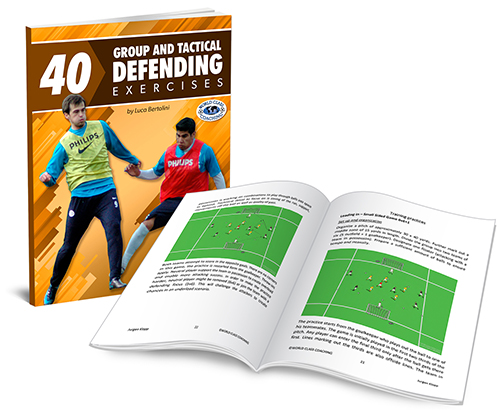
Table of Contents
PART FOUR
Defending With and Against the 3-5-2
1-3-5-2
Exercise 31: 3 + 2 v 3 (1)
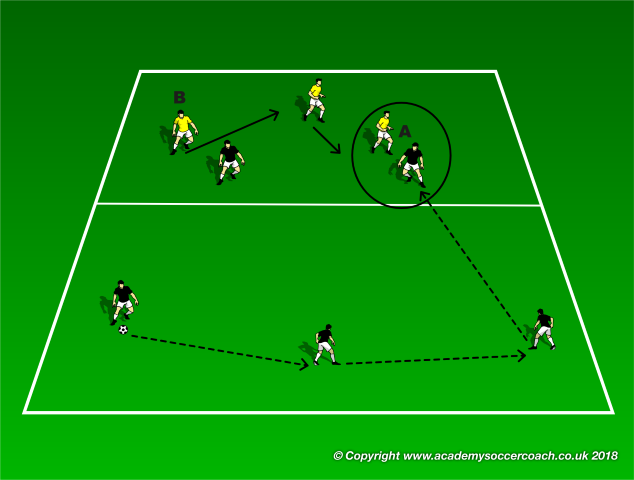
Set-up and Sequence: a rectangular area is divided into 2 parts and 8 players are involved in the exercise. 3 attacking players are freely active inside the lower half, 3 defending players and 2 attackers are placed inside the upper areas, as in the picture.
The 3 players with the possession are free to dribble or pass inside the lower area and the other 2 forwards must try to escape the markers inside the upper area. The defenders must always provide man marking and space coverage at the back, shifting across the upper area. The defenders must be placed as in the situation A in the picture, to prevent the forwards from turning and dribbling over the end line:
• One defender must mark the nearest forward to the ball.
• The second defender must be ready to double the mark.
• The third one must provide balance and be ready to re-organize the same shape against the other opponents (in a potential situation B).
Defense transition phase: if the yellow players recovers the possession, they must dribble toward the opposite area, to dribble over the end line; the black defenders must try to deny space, countering the opposition possession; after 6", 2 forwards can retreat to create defensive numerical advantage (5 v 3).
Tactical key points: organize pressure and balance against the forwards, deny space to avoid counter attacks, delay while waiting for defense support of the teammates.
Exercise 32: 3 + 2 v 3 (2)
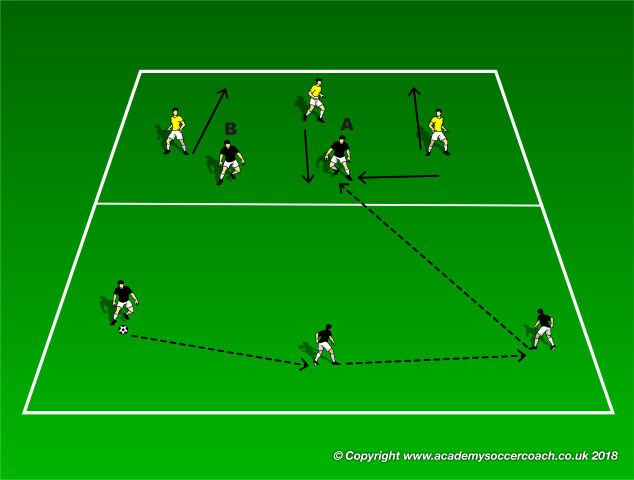
Set-up and Sequence: this exercise is a progression of the previous one. A rectangular area is again divided into 2 parts and 8 players are involved in the exercise. 3 attacking players are freely active inside the lower half, 3 defending players and 2 attackers are placed inside the upper areas, as in the picture.
The 3 players with possession are free to dribble or pass inside the lower area and the other 2 named forwards (A and B) must try to escape the markers inside the upper area. The coach states who is the receiver, who must shift across toward the center of the upper area; the center defender of the back 3 must always provide man marking on him, pressing and trying to anticipate him, while the other 2 must cover the space, retreating at the back of the teammate on the ball.
Defense transition phase: if the yellow players recover the possession, they must dribble toward the opposite area and over the end line; the black defenders must try to deny space, countering the opposition possession; after 6", 2 forwards can retreat to create defensive numerical advantage (5 v 3).
Tactical key points: organize pressure against the forward and coverage and balance at his back, move as a unique block, deny space to avoid counter attacks, delay while waiting for defense support of the teammates.
Exercise 33: 3 + 2 v 3 (3)
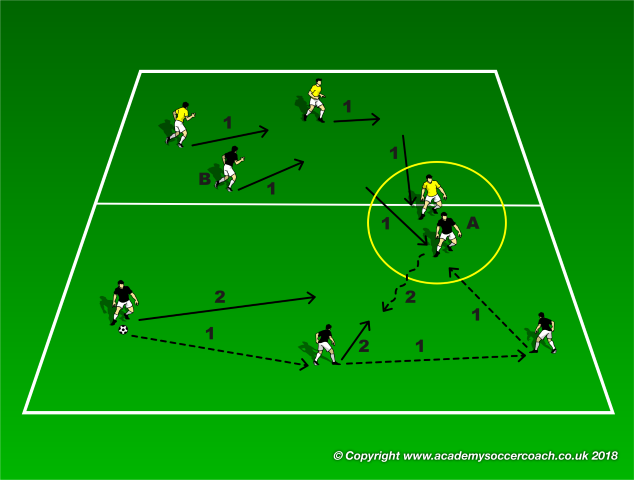
Set-up and Sequence: this exercise is another progression of the num. 29. A rectangular area is again divided into 2 parts and 8 players are involved in the exercise. 3 attacking players are freely active inside the lower half, 3 defending players and 2 attackers are placed inside the upper areas, as in the picture.
The 3 players with possession are free to dribble or pass inside the lower area (1) and the other 2 named forwards (A and B) must try to escape the markers inside the upper area. The coach states who is the receiver, who must drop back inside the lower area; both the wide center defenders of the back 3 must always provide man marking on him (the left one against the forward A), pressing and trying to anticipate him, while the other 2 must cover the space at the back, shifting across to cover the space that is left free.
Defense transition phase: if the yellow defender inside the building up area recovers the possession (2), he must dribble toward the opposite end line; the black players must try to deny space, counter pressing against him to recover the possession (3 v 1), exploiting the numerical advantage.
Tactical key points: shift across covering the spaces, move as a unique block, deny space to avoid counter attacks, counter-pressing actions exploiting the numerical advantage.
Exercise 34: 3 v 2 + 3 v 3 (+1)
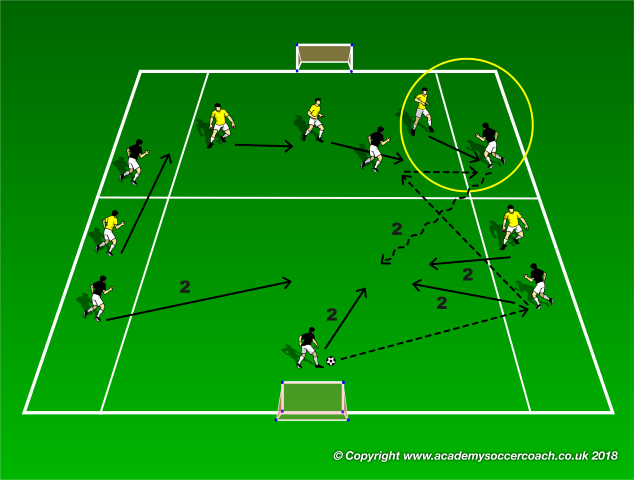
Set-up and Sequence: a rectangular area is divided into 2 center and 4 wide zones, where 11 players are involved. 3 attacking players are active inside the lower half; the center one is free to dribble and to play, but the outer teammates are involved in 1 v 1 duels. 3 yellow defenders are placed inside the upper half of the pitch, against 1 center forward and 2 wide attackers inside the flank areas, as in the picture. 2 goals are placed in the middle of the end lines.
The black player in possession decides where to pass the ball toward the flank (on the right, in the picture); the receiver must be able to pass forward inside the upper center area. The defenders must then close the passing lanes, forcing the ball carrier outside; the same has to be done inside the upper area, where the defenders must shift across the flank, where the ball is being played, to save the goal space. The nearest player to the ball are asked to press on the ball carriers, the opposite back winger is asked to retreat from the lower zone to create a numerical advantage defensive situation 4 v 3.
Defense transition phases:
• If the wingbacks win the possession, the yellow team can counter-attack 5 (2 + 3 incoming players from the center upper area) v 3. The black team must delay the opposition possession for 6", when the wingbacks can retreat to equalize the defense situation (5 v 5), allowing the left and right center backs condensing the center.
• If the possession is recovered at the back (2), a 3 v 3 duel is then played, and the black players must defend forward, counter pressing the opposition possession to deny center spaces.
Tactical key points: shifting across to press the wide ball areas, delay while waiting for defense support of the teammates, counter pressing, deny space condensing the center.
Exercise 35: 5 v 7
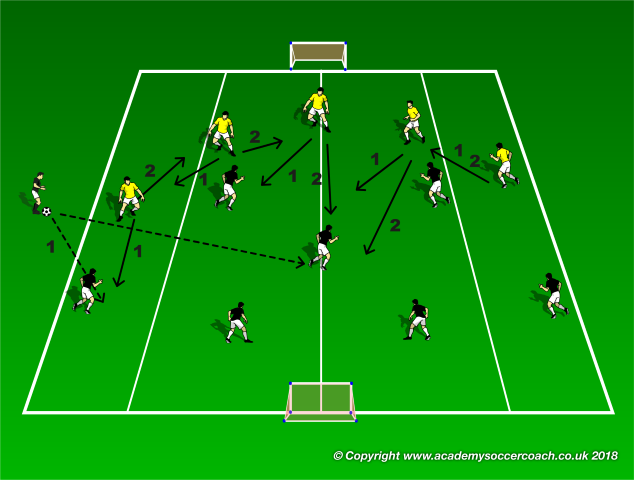
Set-up and Sequence: a rectangular area is divided into 2 center and 2 wide zones vertically, where 12 players are involved. 4 attacking players are placed inside each area in the lower part, the fifth one is active along the centerline and 2 forwards are placed inside the upper part of the center areas. 4 yellow defenders are placed inside each area and the fifth one is active along the middle line. 2 goals are placed in the middle of the end lines.
The coach is in possession and he must start the sequence passing the ball to the black team following 2 possible options:
1) If the coach passes the ball toward a wingback, 3 of the 5 defenders must shift across to create a strong side near it, the fourth one must provide balance near them and the fifth one must cover the space at their back and in front of the goal. Due to numerical disadvantage, the line of 5 must be always balanced at the back to save the depth.
2) If the coach passes the ball toward the center player, the yellow center back must press him while receiving, together with the left or right center back, depending on the direction of ball control (left one in the picture). The other 3 defenders must cover the center areas at the back to save the goal space.
Defense transition phases: if the yellow defenders win the possession, and wherever they are able to do it, immediate counter pressing actions must be taken, to exploit the defensive numerical advantage. The 3 advanced players must be the first ones pressing of the new ball carrier and the 4 defenders must defend running forward to overload the ball area.
Tactical key points: shifting across to press the wide ball areas, pressure, balance and coverage against center attacks, counter pressing, overload the ball area to exploit numerical advantage.
Exercise 36: 6 + gk v 5
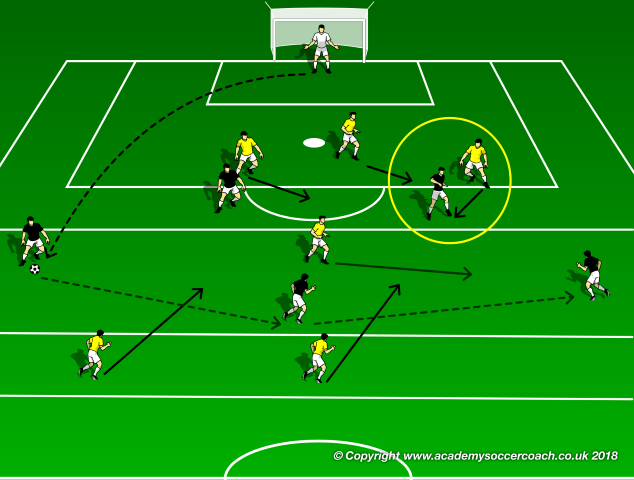
Set-up and Sequence: 1/3 of a regular field is divided into 3 zones. The goalkeeper, 3 center defenders and 2 forwards are placed inside the bigger one (few yards longer than the penalty area), 3 black and 1 yellow midfielders are placed inside the center area and 2 forwards of the defending team are active inside the 3rd zone. The goalkeeper has the possession and he starts the sequences, passing the ball to the black midfielders, who must build up and try to finish. The possession players can't be active out of their positions.
As the first midfielder receives, the 3 defenders at the back must alternate the man mark (or double marking if needed) against the opposition forwards with the coverage of the goal space and balance. The forward who is playing through the same side of the ball position, has to be man marked, the center defender must provide balance (or double the mark) and the third one must cover the space, being ready to man mark the other forward.
The center midfielder must try to close the passing lanes first and then try to tackle the ball carrier, who is going to pass toward the forwards. The forwards of the defending team can retreat after the second pass of the possession team, to equalize the duel (3 v 3); the first forward should help the pressure action on the ball, and the other one should mark the opponent, who is placed on the easiest passing lane.
Defense transition phases: if the defending team wins the possession, the ball must be dribbled over the last line of the playing area.
1) When the ball is recovered inside the middle area, immediate counter pressing actions must be taken to force the possession backward (a 3 v 3 duel is played).
2) If the ball is recovered at the back, a 5 v 5 duel is then played, as one defender of the team now in possession must stand at the back to provide balance. The black team must save the depth, running forward, to avoid the opposition from dribbling inside the last third of the field.
Tactical key points: balance the man marking and space coverage, delay the opposition possession, retreat to equalize a numerical disadvantage situation, counter pressing to send the opposition backward.
Exercise 37: 5 + gk v 6 (1)
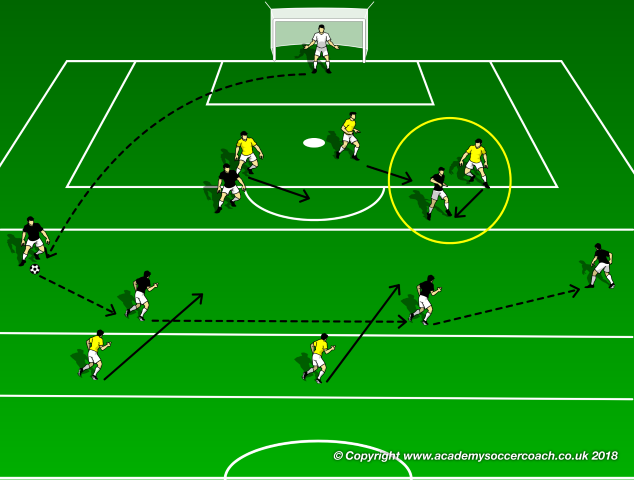
Set-up and Sequence: this exercise is a progression of the previous one. The defending team is now outnumbered (5 v 6). 1/3 of a regular field is again divided into 3 zones. The goalkeeper, 3 center defenders and 2 forwards are placed inside the bigger one (few yards longer than the penalty area), 4 black midfielders are placed inside the center area and 2 forwards of the defending team are active inside the 3rd zone. The goalkeeper has the possession and he starts the sequences, passing the ball to the black midfielders, who must build up and try to finish. The possession players can't be active out of their positions.
As the first midfielder receives, the 3 defenders at the back must alternate the man mark (or double marking if needed) against the opposition forwards with the coverage of the goal space and balance. The forward who is playing through the same side of the ball position, has to be man marked, the center defender must provide balance (or double the mark) and the third one must cover the space, being ready to man mark the other forward.
The forwards of the defending team can retreat after the first ball reception of the possession team, recovering the space and trying to force the direction of play outside.
Defense transition phases: if the defending team wins the possession, the ball must be dribbled over the last line of the playing area.
1) When the ball is recovered inside the middle area, immediate counter pressing action must be taken to recover the possession, exploiting the numerical advantage (a 4 v 2 duel is played)
2) If the ball is recovered at the back, a 4 v 6 duel is then played, as one defender of the team now in possession must stand at the back to provide balance, due to the general numerical disadvantage. The black team counters press to win the ball or to force the direction of play backward, preventing the team now in possession from playing or dribbling the ball inside the last third.
Tactical key points: balance the man marking and space coverage, delay the opposition possession, retreat to equalize a numerical disadvantage situation, counter pressing to send the opposition backward.
Exercise 38: 5 + gk v 6 (2)
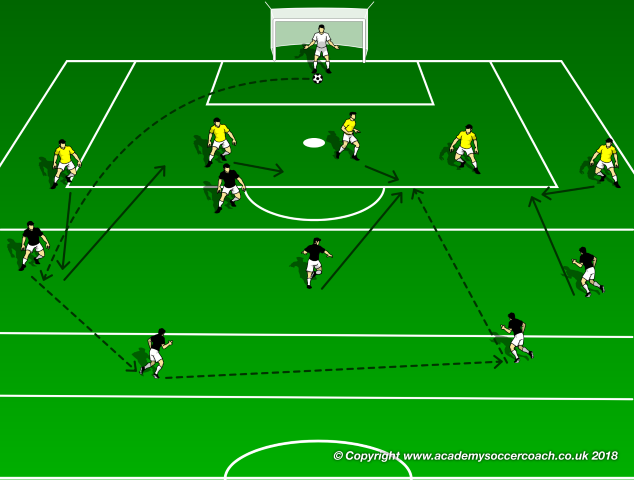
Set-up and Sequence: this exercise is another progression of number 36. The defending team is now outnumbered (5 v 6) at the beginning, but all the 5 players are defenders (back 5). 1/3 of a regular field is again divided into 3 zones. 1 black forward is placed inside the final third against the defenders, 3 black midfielders are placed inside the center area and 2 more black players are active inside the 3rd zone. The goalkeeper has the possession and he starts the sequences, passing the ball to the black midfielders, who must build up from the first third and try to finish.
As the first outer midfielder receives, the wingback can try to press him while receiving, before retreating back to reshape the defense line, if the receiver is able to pass back. As the ball is played inside the building up area, it can't be played again inside the middle third; the other forward must run inside their final third to receive and finish.
The defenders must close the space to prevent through passes, counter the opposition forwards while receiving or track their cutting runs attempts. The outer center backs and the wingbacks should overload the center; as the defense line has the numerical advantage inside the first third (5 v 3), strong pressure is required to win the ball back. The 3 other black players must provide balance inside the middle third.
Defense transition phases: if the defending team wins the possession, the ball must be dribbled over the last line of the playing area within 6" (5 v 3), before the other 3 black players can retreat and create defensive numerical advantage (6 v 5).
Tactical key points: close the spaces to avoid through passes, overload the space in front of the goal delay the opposition possession, retreat to create a defensive numerical advantage situation.
Exercise 39: 8 + gk v 7
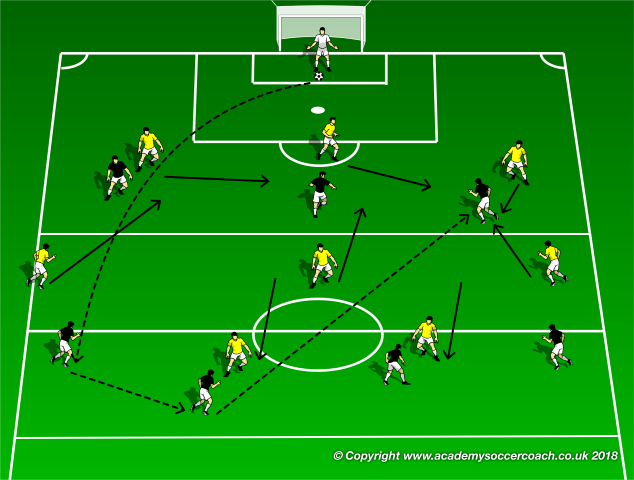
Set-up and Sequence: a playing space equal to a half of a regular field + 15 yards is divided as in the picture. The defending team has the general numerical advantage (8 v 7); a 3 + gk v 3 forwards duel is played inside the first third, 5 midfielders of the defending team are placed inside the middle third and 4 black defenders are placed inside the final third. The yellow goalkeeper has the possession and he starts the sequence, passing the ball toward the defenders of the black team.
As the first outer defender receives, 2 midfielders can press the possession phase of the opponents and the other 3 must create numerical advantage at the back (5 v 3); the sixth yellow player must double the mark against the most dangerous attacker of the opposition. When the ball is played inside the building up area, it can't be played again inside the middle third; the other forwards must run inside their final third to receive and finish.
The defenders must close the space to prevent through passes, counter the opposition forwards while receiving or track their cutting runs attempts. The outer center backs and the wingbacks should overload the center; as the defense line has the numerical advantage inside the first third (6 v 3), strong pressure is required to win the ball back. The 3 other black players must provide balance inside the middle third.
Defense transition phases: if the defending team wins the possession, the move must be carried out inside the middle and the final third; the goal is to dribble over the end line of the playing area. The team now without possession must save the depth, delaying the opposition possession, waiting for the teammates retreating, to limit the disadvantage.
Tactical key points: close the spaces to avoid through passes, overload the space in front of the goal delay the opposition possession, retreat to create a defensive numerical advantage situation.
Exercise 40: 7 v 7 with gks + 3
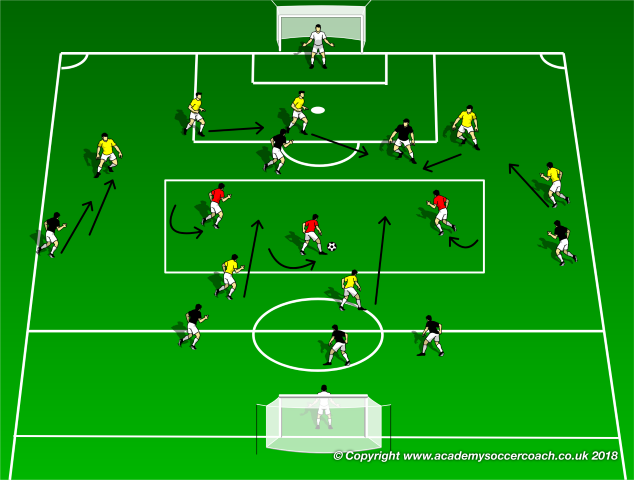
Set-up and Sequence: a playing space equal to a half of a regular field + 15 yards is marked on a regular field. Both the yellow and black teams have 1 goalkeeper and 7 field players, which are shaped in a 5-2 formation. 3 red free players are active inside a rectangular center area; one of them has the possession and he decides the direction of play, as well as the attacking (black) and defending team (yellow), turning the body toward the goal to attack.
As the red free player turns to start the sequence, the forward of the defending team can run inside the center area, retreating back, to press them and try to avoid forward passes; from now on, the free players and the wingbacks shape the attack sector and the other 3 players provide balance the back (a 7 v 7 duels is then played).
The center yellow defenders must close the goal space and the wingbacks must run back quickly to shape a line of 5.
Defense transition phases: if the defending team wins the possession, 4 possible transition (to defend and to attack) phases can be played:
1) The red free players and 2 yellow attackers shape a 5 v 5 duel against 3 black center backs and the wingbacks, who must run back quickly to shape a back line of 5.
2) The red free players are inactive and the yellow and black teams (the forwards and the wingbacks must retreat as soon as possible) play a 7 v 7 duel
3) The red free players become midfielders of the 1-5-3-2 formation of the yellow team against 7 black players; the defending team must then save the depth.
4) The red free players become midfielders of the 1-5-3-2 formation of the black defending team against 7 yellow possession players; the defending team must then counter press to win the ball back within 6".
Tactical key points: close the spaces to avoid through passes, retreat to shape the defense line, save the depth, counter pressing to recover the possession as high in the field as possible.


